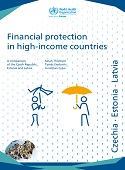Financial protection in high-income countries. A comparison of the Czech Republic, Estonia and Latvia (2018)

Download
2018, v + 44 pages
ISBN 978 92 890 5325 9
This publication is only available online.
This report compares financial protection across 3 countries that are similar in many ways but experience very different levels of financial hardship. The incidence of catastrophic and impoverishing out-of-pocket payments is low in Czechia, much higher in Estonia and among the highest in the WHO European Region in Latvia.
Differences in financial hardship are partly explained by variations in health spending across the 3 countries. An increase in public spending on health in Estonia and Latvia would help to lower the out-of-pocket share of total spending on health.
Coverage policy – the way in which health coverage is designed and implemented – is an equally important explanatory factor. The weak design of user charges (co-payments) for outpatient medicines in Estonia and Latvia shifts health-care costs onto those who can least afford to pay: poor people, people with chronic conditions and older people.
In contrast, co-payment policy in Czechia is relatively strong: co-payments are used sparingly; they are set as a low fixed co-payment rather than a percentage of price; vulnerable people are exempt; and there is a cap on all co-payments for everyone. As a result, catastrophic incidence is low, outpatient medicines are accessible and pensioners do not experience undue financial hardship.



